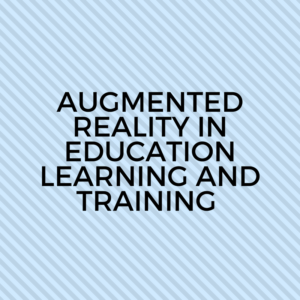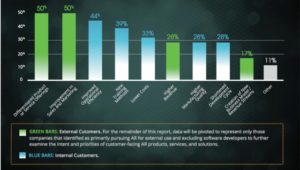AR has garnered a great deal of interest over the past few years for its clear applicability in industrial maintenance and repair applications as well as operator training. The question is, how quickly is industry adapting to and adopting this technology.
Though it does not provide a broad analysis in terms of overall industry adoption of augmented reality (AR) technologies, a mid-year update from PTC on its “State of Industrial Augmented Reality” report does provide good insights into current applications of AR among PTC’s Vuforia and Vuforia Studio customers.
According to the report, the majority of PTC customers piloting and adopting AR for internal use noted improvements in “operational efficiency” and “lower costs” as the main drivers of their interest in AR. At the same time, 50 percent of respondents noted “differentiated product or service offerings” and “improvement in sales and marketing” as key business goals they looked to address with AR initiatives.
This finding in the PTC research seems to indicate a confluence of purpose for AR in both internal and external (customer-facing) applications. As stated in the report: “Driven by the same high downtime costs forcing companies to develop AR maintenance experiences internally, customers of industrial enterprises are open to receiving value-add services that utilize AR to reduce downtime and streamline their service experience. The path to value that PTC observes is that pilots start with internal proof of concept and quickly become deployed across multiple areas, including customer-facing product and service initiatives.”
Given that a good bit of attention has already been paid to AR use for internal maintenance / operation applications, I found it interesting to learn how widely customer-facing applications of AR are already being applied.
According to the PTC report, 26 percent of respondents developing customer-facing applications said those applications are service related, i.e., providing instructions to the customer to pre-empt and reduce service calls or equipping service teams with service inspection apps to increase first-time fix rate. These respondents note that the ultimate goal of service-related AR is to “maximize the value customers receive from their products.”
Another 20 percent of respondents use customer-facing AR to “extend a customer’s ‘operator’ experience with the product via operator and assembly instructions to guide customers through product setup and operation to ensure safe and compliant product use.
Surprisingly, the PTC report notes that companies using AR for customer-facing applications report “having completed successful use case development at nearly three times the rate of those developing internal use cases (29 percent versus 11 percent).” PTC thinks a reason for this disparity could be that companies developing for internal use may be “experimenting more with AR technology to find the best fit for optimizing their internal operations. They may also be taking on more ambitious projects, such as integrating enterprise systems or building use cases that span multiple functions in the value chain.”
Regardless of whether the company is pursuing internal or external use of AR, PTC says its research shows that the majority of enterprises pursuing “any flavor of augmented reality are standing up projects and experiencing ROI within 12 months.”
With such a high-focus on customer-facing AR applications among its AR users, PTC spotlighted a few case study examples of companies deploying the technology for this purpose in its report. In one example highlighting the internal use of AR to help customers address product problems, Trox do Brasil, a manufacturer of central air conditioning components, is enabling augmented service manuals and instructions, service inspection, and remote expertise to ensure they can instruct and guide customers through repairs and maintenance hurdles. “These new service capabilities will reduce the need for on-site service trips in addition to reducing the customers’ downtime and improving their overall experience and value from Trox do Brasil’s products,” states the PTC report.
A more direct customer-facing example of AR application is being used by Cannondale, a global supplier of cycling equipment. The company offers a bike called Lefty Ocho, which ships with AR companion experiences that include operator and assembly instructions. In its report, PTC says this functionality helps customers learn about “the features of their new bike, mechanics, and proper use to ensure the safest and best product experience possible. It also provides a key voice-of-the product feedback loop for Cannondale to incorporate into product development in addition to reducing basic customer service calls and questions.”









